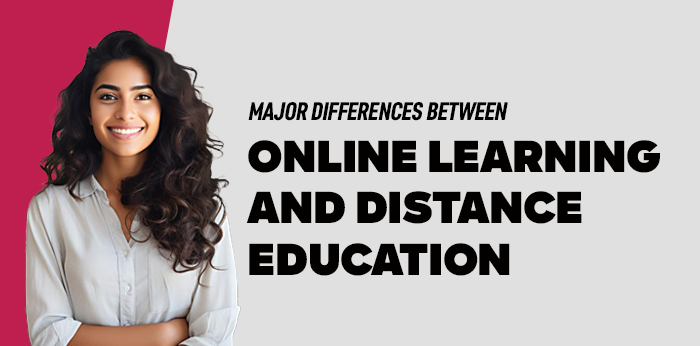
In today’s digital age, education has blossomed beyond the four walls of the traditional classroom. The internet has ushered in a wave of learning opportunities, offering alternatives like online learning and distance education. But with so many options available, the question arises: what exactly differentiates these two educational paths? And more importantly, which one best suits your aspirations and learning style?
This article serves as your guide, in untangling the complexities of Online learning vs. distance education. We’ll delve into their similarities, highlight their unique characteristics, and explore the pros and cons of each method. By the end, you’ll be equipped to make an informed decision about which path propels you toward your educational goals.
Distance learning, also referred to as remote education or correspondence course, is a contemporary form of learning that has proven to be a valuable means of acquiring knowledge outside of a traditional classroom.
The students irrespective of school or college need not be physically present as they receive their course material by post or email. There is less teacher interaction as this type of learning provides individual independent study.
There are certain programs that advocate students to combine the Advantages of distance education with the classroom in case of workshops, labs and all. This particular mode is called a hybrid mode. It provides students with the freedom to pursue their education without being limited by geographical boundaries or scheduling constraints.
With the help of Online learning platforms and interactive tools, learners have access to high-quality course materials, virtual interactions with instructors and peers, and the ability to learn at their own pace. With its streamlined approach to education, distance learning allows for a seamless learning experience.
E-learning, or online learning, allows individuals to gain knowledge and skills through internet-based Online learning platforms. This modern form of education eliminates the need for traditional classrooms and instead offers a variety of engaging resources, such as pre-recorded video lectures, interactive modules, virtual classrooms, and self-paced learning materials.
Utilising the internet, learners can access these resources and easily communicate with instructors and peers, making online learning versatile and easily customised to fit personal schedules.COVID-19 has had a great impact on the mode of education, however, online learning evolved almost remarkably post-COVID.
This vast e-learning era enables students access to vast e-learning content and even live and recorded online lectures.
This interactive form of learning has the upper hand advantages of distance education as it provides a flexible learning atmosphere essential for the educational growth of individuals as such.
Comparing the advantages of distance education and online learning, whether someone is looking to advance their professional abilities, continue their education throughout their lifetime, or overcome geographical obstacles, distance learning offers a wide range of options to cater to diverse needs and preferences but the level of interaction between teachers and students are is leafs compared to that in online education. This interaction is essential for the development of students throughout the learning process.
| Feature | Online Learning | Distance Education |
| Delivery Method | Primarily online, using virtual classrooms, LMS, interactive multimedia | Varies, can include traditional printed materials, audio/video lectures, online components |
| Interaction | Real-time interaction with instructors and peers through video conferencing, online discussions, chat rooms | Asynchronous communication with instructors and peers through email, forums, phone calls |
| Technology Dependence | High reliance on reliable internet access and various digital tools | Lower reliance on technology, may not require constant internet access |
| Flexibility | Flexible schedule and location, learn at your own pace | Highly flexible schedule and pace, self-directed learning |
| Cost | Potentially lower travel and accommodation costs, but program fees may vary | Potentially lower overall program costs, but additional resource costs possible |
| Learning Style | Suitable for interactive, collaborative learners | Suitable for self-directed, independent learners |
| Community | Strong sense of community through online interactions | Limited opportunities for in-person interaction, community building may require extra effort |
| Engagement | Dynamic and engaging environment with multimedia resources | Potentially lower overall program costs, but additional resource costs are possible |
| Accessibility | Requires reliable internet access and technology | May be suitable for learners with limited internet access, but printed materials can be bulky |
| Support | Access to online support services, instructors, and peers | May have limited support options, requires proactive communication |
While they share commonalities, the Pros and cons of online learning and distance education also have distinct characteristics:
Remember, there’s no “one size fits all” approach to education. By carefully considering your individual needs and preferences, exploring both online learning and distance education options, and diligently researching available programs, you can confidently pave the way toward a successful and fulfilling educational journey.